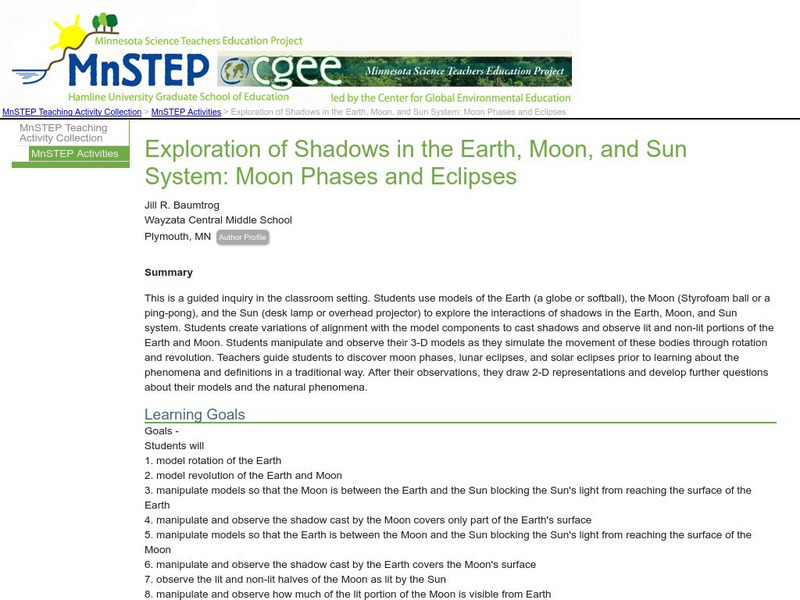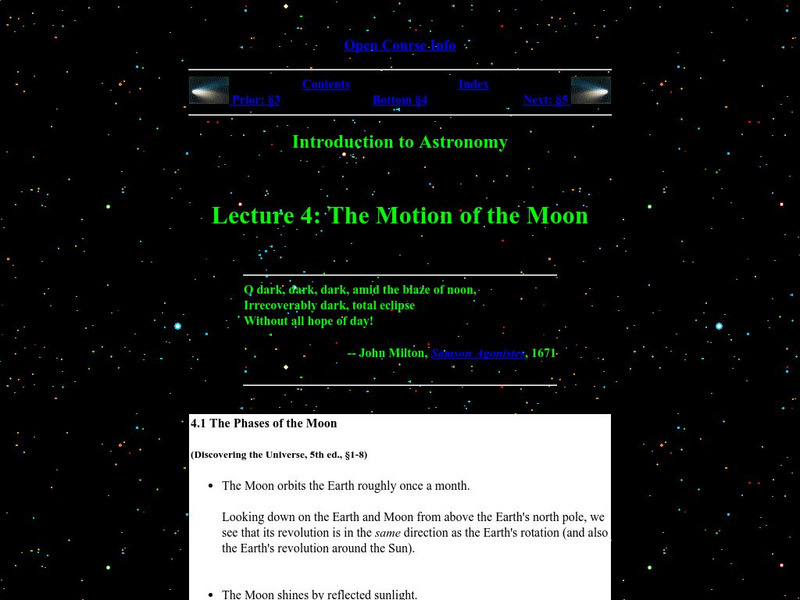Hi, what do you want to do?
Curated OER
The Path of the Sun: The Ecliptic
Students investigate the celestial sphere and the paths it takes in the solar system.
Curated OER
The Vocabulary of Space
Students build their knowledge and understanding of vocabulary related to space. In this space instructional activity, students discuss four categories of words and phrases related to space.
Curated OER
"Space" Investigations
Sixth graders understand the patterns of change observable on Earth as a result of the movement of the different bodies in the solar system. They identify the physical characteristics of the different components of the solar system.
Curated OER
Charting Seasonal Changes
Students research the Earth's patterns of rotation and revolution, create a chart and graph of these patterns and use them to explain the causes of night and day and summer and winter.
NASA
Nasa: Solar and Lunar Eclipses
Information on solar and lunar eclipses for current year as well as past and future.
Other
Hermit.org Science: Mechanics of Lunar Eclipses
An good site for information about Lunar Eclipses, with excellent diagrams. This page has the best viewing graphics, but a printable page can be easily selected.
Georgia Department of Education
Ga Virtual Learning: The Moon
In this interactive tutorial students will explore what it is like on the Moon. Learn why the shape of the Moon seem to change and also about lunar eclipses. Discover why the tide changes twice a day and explore how the cycle of the Moon...
CK-12 Foundation
Ck 12: Fifth Grade Science: Earth Science: The Sun Earth Moon System
[Free Registration/Login may be required to access all resource tools.] Discusses solar and lunar eclipses, the phases of the Moon, and why the phases occur.
NASA
Nasa: Lunar Prospector: Lunar Eclipse
What happens to a spacecraft that relies on sunlight to power its batteries when it travels through the Earth's shadow? The Lunar Prospector survived several Penumbral and Umbral eclipses. Resource includes a link to a video that...
Other
Lunar Eclipses for Beginners
What is a lunar eclipse? What causes eclipses? How often do eclipses happen and when is the next lunar eclipse? You'll find the answers to these questions and more on this site on lunar eclipses.
Space.com
Space: 'Snow Moon' Eclipse & Green Comet a Double Treat for Skywatchers
A penumbral lunar eclipse and a bright green comet gave skywatchers across the globe a double treat Friday night (Feb. 10) and early into Saturday morning.
Enchanted Learning
Enchanted Learning: Lunar Eclipse
A brief description of what a lunar eclipse is, the types of lunar eclipses, and the frequency and duration of lunar eclipses. Includes a diagram of a lunar eclipse along with a worksheet for students to label.
Sophia Learning
Sophia: Eclipses
A introductory lesson plan explaining the differences between lunar and solar eclipses.
Cosmos 4 kids
Cosmos4 Kids: Systems: Eclipses
Find out about the differences between solar and lunar eclipses and what causes both events to occur.
Science Education Resource Center at Carleton College
Serc: Exploration of Shadows: Earth, Moon, Sun System: Moon Phases Eclipses
A guided inquiry where students participate in the simulation of moon phases and eclipses.
NASA
Nasa: Eclipses
The periodicity and recurrance of eclipses is governed by the Saros cycle, a period of approximately 6,585.3 days (18 years 11 days 8 hours). It was known to the Chaldeans as a period when lunar eclipses seem to repeat themselves, but...
Other
Introduction to Astronomy: The Motion of the Moon
This site provides a moving diagram of a Lunar eclipse, showing Earth's umbra and penumbra and the appearance of the Moon as it passes through these shadow regions.
Other
Mas: Lunar Photography With Telephoto Lenses
Ever taken a picture of a nice large full Moon, only to find that it looks like a small dot on your finished photograph? This site explains why, and offers tips on taking good pictures of the Moon.
Space.com
Moon Facts: Fun Information About the Earth's Moon
How did the moon form? Learn the answer to this and numerous other fun facts in this article from Space.com.
Cornell University
Cornell University: Astronomy: Eclipses
This site from the Astronomy Department of Cornell University provides brief introduction to both solar and lunar eclipses. Links are provided for pictures and charts of the eclipses, and this is a good site to check out on the subject.
Curated OER
Lunar Eclipse Animation
This site provides a moving diagram of a Lunar eclipse, showing Earth's umbra and penumbra and the appearance of the Moon as it passes through these shadow regions.
The Wonder of Science
The Wonder of Science: Ms Ess1 1: Earth Sun Moon System
Develop and use a model of the earth-sun-moon system to describe the cyclic patterns of lunar phases, eclipses of the sun and moon, and seasons.























